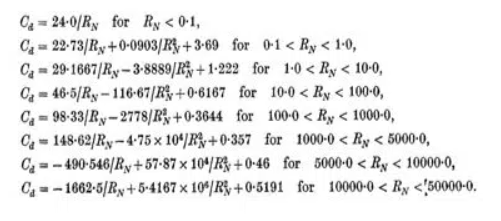TAGGED: coefficient-of-drag, dpm, drag-force
-
-
January 28, 2023 at 11:56 am
Thodorisdm
SubscriberDear,
I am using the Euler-Lagrange approach to simulate the trajectories of solid particles( d=3-4mm) in my flow (Re up to 10^4).
I am planning to use the spherical drag law. However, when checking up to which Reynolds number the a1, a2, a3 coefficients are calculated, I found that the maximum Re is 5*10^4. Therefore, my questions is what happens to the regions in my flow which have a higher Re than that? How is the Cd calculated there? Is it constant?
Thank you in advance.
Kind regards,
-
January 30, 2023 at 5:45 am
SRP
Ansys EmployeeHi,
The drag will be calculated based on changing the ampltitude of the particle Reynolds number and fitting to the experimental results based on changing three coefficients.
Hope you find this useful.
Thank you
Saurabh
-
January 30, 2023 at 9:04 am
Amine Ben Hadj Ali
Ansys EmployeeThe default spherical drag law will take care about having higher Reynolds-Number range (so more or less Newtonian drag for solid particles). Check the Theory Guide to know more about Morsi-Alexander drag law.
-
January 30, 2023 at 10:22 am
Thodorisdm
SubscriberThank you for the answers.
- Could you specify the chapter that explains more about Morsi-Alexxander drag law? Because in chapter 12.3.1 it does not specify anything about the abovementioned drag law, it only gives the formula.
- I dont understand what do you mean by will take care since the are no coefficients (no function) for Reynolds numbers above 50000, as you can see in the picture attached. Or may I understood something wrong?
Thank you in advance
-
January 30, 2023 at 10:40 am
Amine Ben Hadj Ali
Ansys EmployeeMultiphase Chapter under Fluid-Fluid Exchange Coefficient (Using Search feature is helpful). Fluent formulation does not cap at 50000. Validation and deployment of any correlations are something else which can be discussed.
-
January 30, 2023 at 10:51 am
Amine Ben Hadj Ali
Ansys EmployeeIf you are concerned with drag in supercritical region then you probably need to implement your own corrleation.
-
January 30, 2023 at 12:13 pm
Thodorisdm
SubscriberI found the chapter you were referred to and it is has clarified how is the Morsi and Alexander drag law formulated in Fluent.
For people who might have the same question in the future : Fluent uses the coefficients from the above image with only difference found in the regions defined. Moreover, the last particle Reynolds number is defined as Re_p>= 10000 which is a valid assumption up to Re_p <= 2*10^5
-
- The topic ‘DPM-Spherical drag law’ is closed to new replies.


- air flow in and out of computer case
- Varying Bond model parameters to mimic soil particle cohesion/stiction
- Eroded Mass due to Erosion of Soil Particles by Fluids
- I am doing a corona simulation. But particles are not spreading.
- Centrifugal Fan Analysis for Determination of Characteristic Curve
- Guidance needed for Conjugate Heat Transfer Analysis for a 3s3p Li-ion Battery
- Issue to compile a UDF in ANSYS Fluent
- JACOBI Convergence Issue in ANSYS AQWA
- affinity not set
- Resuming SAG Mill Simulation with New Particle Batch in Rocky

-
4052
-
1482
-
1308
-
1156
-
1021

© 2025 Copyright ANSYS, Inc. All rights reserved.








